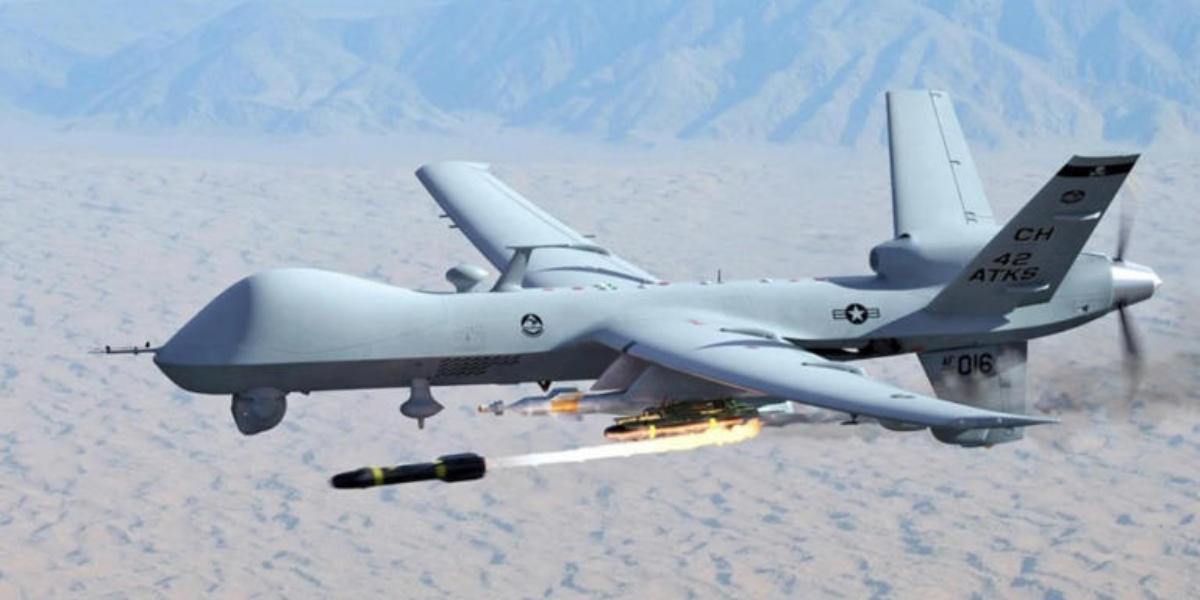In a significant development, the Biden Administration has signaled a strong commitment to India’s defence capabilities by informing the US Congress of a substantial arms and weapons deal worth nearly 4 billion dollars. This strategic move not only fulfills India’s pressing defence needs but also marks a pivotal moment in the growing partnership between India and the United States. At the heart of this deal are the MQ-9B Drones armed with Hellfire missiles, poised to enhance India’s military prowess. Let’s delve into the details of this transformative defence agreement, exploring its implications and the key components that make up this substantial arms deal.

Table of Contents
The Defence Deal :
The Defence Security Cooperation Agency, a crucial entity within the US Department of Defence, issued a press release highlighting the importance of the arms sale to India. The deal includes the sale of MQ-9B Remotely Piloted Aircraft, commonly known as drones, and related equipment, amounting to an estimated cost of $3.99 billion. This showcases the Biden Administration’s commitment to fortifying the US-Indian strategic relationship.
Political Stability and Economic Progress in the Indo-Pacific:
The press release emphasizes India’s crucial role in promoting political stability, peace, and economic progress in the Indo-Pacific and South Asia region. This acknowledgment reinforces the United States’ recognition of India as a major defence partner.
Key Components of the Defence Deal:
MQ-9B Sky Guardian Aircraft:
The Indian government’s request includes the acquisition of 31 MQ-9B Sky Guardian aircraft, signifying a substantial addition to India’s aerial capabilities. These drones are equipped with advanced technology and are poised to play a crucial role in unmanned surveillance and reconnaissance.
Embedded Global Positioning and Inertial Navigation Systems (EGIs):
To bolster the precision and navigational capabilities of the MQ-9B drones, the deal incorporates the purchase of 161 Embedded Global Positioning and Inertial Navigation Systems.

L3 Rio Grande Communications Intelligence Sensor Suites:
Enhancing communication intelligence capabilities, the deal includes 35 L3 Rio Grande Communications Intelligence Sensor Suites, providing India with an edge in modern warfare strategies.
AGM-114R Hellfire Missiles:
A critical component of the arms deal, India is set to acquire 170 AGM-114R Hellfire missiles, demonstrating a commitment to bolstering offensive capabilities.
M36E9 Hellfire Captive Air Training Missiles (CATM):
To ensure effective training, the deal includes 16 M36E9 Hellfire Captive Air Training Missiles, allowing Indian forces to hone their skills in a controlled environment.
GBU-39B/B Laser Small Diameter Bombs (LSDB):
The acquisition of 310 GBU-39B/B Laser Small Diameter Bombs further enhances India’s precision strike capabilities, contributing to a well-rounded defence strategy.
GBU-39B/B LSDB Guided Test Vehicles (GTVs):
The deal encompasses eight GBU-39B/B LSDB Guided Test Vehicles with live fuzes, enabling India to test and validate the performance of these guided munitions.
Foreign Military Sale Impact:
Strengthening the US-Indian Strategic Relationship:
The Defence Security Cooperation Agency emphasizes that the proposed sale is instrumental in strengthening the strategic relationship between the United States and India. This collaboration aligns with the foreign policy and national security objectives of the United States.
India’s Role in Political Stability and Economic Progress:
Reiterating India’s importance, the release underscores its role as an “important force for political stability, peace, and economic progress in the Indo-Pacific and South Asia region.” This recognition positions India as a key player in regional stability and progress.

Enhanced Capability to Meet Current and Future Threats:
The arms deal is designed to enhance India’s capability to meet “current and future threats” by enabling unmanned surveillance and reconnaissance patrols in crucial sea lanes of operation. This capability upgrade underscores India’s commitment to modernizing its military.
The Proposed Sale’s Implications:
No Alteration of Regional Military Balance:
Addressing concerns, the release assures that the proposed sale will not alter the basic military balance in the region. This statement seeks to allay fears and maintain stability in the geopolitical landscape.
Enhancing India’s Military Modernization Efforts:
The proposed sale is positioned as a catalyst for India’s ongoing military modernization efforts. The acquisition of advanced weaponry and technology aligns with India’s commitment to staying ahead of evolving security challenges.
Principal Contractor: General Atomics Aeronautical Systems:
The principal contractor for this extensive arms deal is General Atomics Aeronautical Systems, headquartered in Poway, CA. The release highlights the key role this contractor will play in facilitating the implementation of the proposed sale.
No Adverse Impact on US Defence Readiness:
Providing assurance, the release asserts that the implementation of this proposed sale will not result in any adverse impact on US defence readiness. This statement is crucial in addressing concerns related to the diversion of resources from US defence priorities.

Conclusion:
As we conclude our exploration of this monumental India-US defence deal, it is evident that this agreement is not merely about the acquisition of weapons; it signifies a deeper commitment to collaboration, strategic alignment, and shared security objectives. The MQ-9B drones armed with Hellfire missiles represent a leap forward in India’s defence capabilities, enhancing its ability to address contemporary and emerging threats.
Broader Geostrategic Implications:
This arms deal is not isolated; it carries broader geostrategic implications for the Indo-Pacific region. India’s growing partnership with the United States not only solidifies its position as a major defence partner but also contributes to regional stability and security.
Continued Evolution of Defence Cooperation:
The proposed sale underscores the continued evolution of defence cooperation between India and the United States. It marks a chapter in the ongoing narrative of strategic collaboration, technological exchange, and mutual support in the face of complex geopolitical challenges.
In conclusion, as India prepares to integrate the MQ-9B drones and associated weaponry into its military arsenal, the nation takes a significant stride towards modernization and preparedness. The collaboration with the United States not only enhances India’s defence capabilities but also sets the stage for continued cooperation in the realm of security and strategic partnerships. This defence deal is a testament to the evolving dynamics of global security and the pivotal role that India plays in shaping the future of the Indo-Pacific region.

